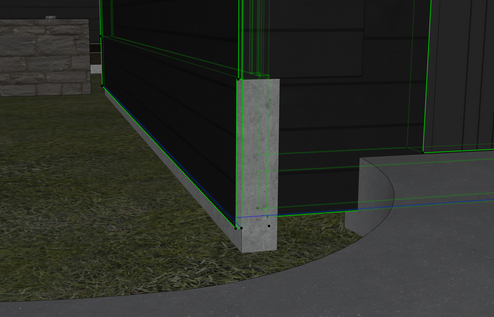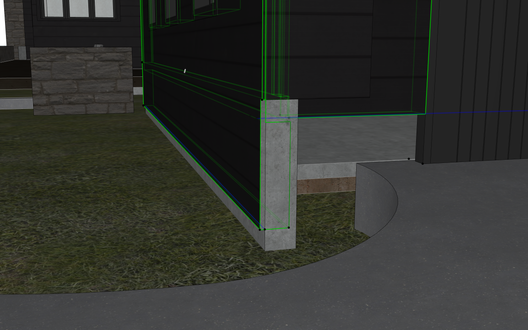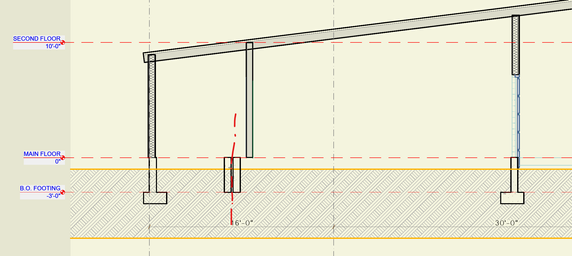- Graphisoft Community (INT)
- :
- Forum
- :
- Documentation
- :
- Re: Interaction Between Walls and Floors in Sectio...
- Subscribe to RSS Feed
- Mark Topic as New
- Mark Topic as Read
- Pin this post for me
- Bookmark
- Subscribe to Topic
- Mute
- Printer Friendly Page
Interaction Between Walls and Floors in Section
- Mark as New
- Bookmark
- Subscribe
- Mute
- Subscribe to RSS Feed
- Permalink
- Report Inappropriate Content
2023-02-13
06:39 PM
- last edited on
2023-05-17
12:46 AM
by
Gordana Radonic
Hello, I am having issues with the wall assembly displaying correctly in relation to another wall and the site grade, modeled as a slab in the section view. In this example, the concrete footing should be in the foreground of both the earth "slab" and the framed wall above it. Typically, I can adjust the display order to fix this visually. The concrete wall is at the highest display order and the ground is the lowest. Also, the concrete material priority is higher than any of the other materials in this scene. The different layers have the same Intersection Group Number of 1. I adjusted the junction order of the concrete wall from 8 to 1 and for a moment it looked correct and then I changed views and came back to it and it no longer worked. The upper wall has a junction order of 8. There aren't any solid element operations happening. Also, I'm using archicad 26. I'm at a loss for what other toggles I can work adjust to make this look right.
It also seems that the concrete wall is interacting with the slab and wall above it in a way that they're both cutting voids into the concrete, the opposite of what I'm aiming for here.
Thanks
WINDOWS PC, 16GB RAM, Intel(R) Core(TM) i7-3770 CPU @ 3.40GHz 3.40 GHZ, NVIDIA GEForce GTX 970, ASUS, CM6870, Rev X.0x
- Mark as New
- Bookmark
- Subscribe
- Mute
- Subscribe to RSS Feed
- Permalink
- Report Inappropriate Content
2023-02-15 07:56 PM
I recently transitioned to ArchiCAD 26 and reorganized all of my layers with the new folder structure. I realized that the folders also have an Intersection Group number which was blank when I created each folder. I assigned a number to each one and that solved it.
WINDOWS PC, 16GB RAM, Intel(R) Core(TM) i7-3770 CPU @ 3.40GHz 3.40 GHZ, NVIDIA GEForce GTX 970, ASUS, CM6870, Rev X.0x
- Mark as New
- Bookmark
- Subscribe
- Mute
- Subscribe to RSS Feed
- Permalink
- Report Inappropriate Content
2023-02-16 02:27 AM
That shouldn't make any difference.
That simply (temporarily) set all the layers in that folder to have the same intersection grouping number.
As soon as you select a layer combination it will reset the priority for the layers based on what was saved in the combination.
The folder will then show just a dash ( - ) if the layers in it have different numbers.
Make sure the layer combination you are using for you section have the correct layer numbers.
Barry.
Versions 6.5 to 27
i7-10700 @ 2.9Ghz, 32GB ram, GeForce RTX 2060 (6GB), Windows 10
Lenovo Thinkpad - i7-1270P 2.20 GHz, 32GB RAM, Nvidia T550, Windows 11
- Mark as New
- Bookmark
- Subscribe
- Mute
- Subscribe to RSS Feed
- Permalink
- Report Inappropriate Content
2023-02-17 06:33 PM
Thanks for clarifying how that folder structure works with the priority numbers, that makes sense. Changing the priority number of the layer for the site grade worked, but I'm still having an issue with these two stacking walls not interacting correctly. The layer combination is saved as having both of these layers on the same priority, number 1, and still they are interacting with the upper wall having more priority, even with materials priority being higher for the lower concrete portion. It's also weird that it's only happening for small segment of where the walls overlap, not the whole overlap.
WINDOWS PC, 16GB RAM, Intel(R) Core(TM) i7-3770 CPU @ 3.40GHz 3.40 GHZ, NVIDIA GEForce GTX 970, ASUS, CM6870, Rev X.0x
- Mark as New
- Bookmark
- Subscribe
- Mute
- Subscribe to RSS Feed
- Permalink
- Report Inappropriate Content
2023-02-18 04:38 AM
If you take the slab away, do the wall trim as you would expect?
It is really hard to say without having the actual model to dissect.
The reference lines of the walls appear to be the same (good), but does the slab extend to that reference line as well?
My guess is the slab is cutting one of the wall (concrete one?) leaving a gap in that, so the concrete wall has nothing to cut the framed wall and the slab is not cutting the framed wall either.
It might just be an issue with building material strengths or it could be the extent of the side of the slab.
Barry.
Versions 6.5 to 27
i7-10700 @ 2.9Ghz, 32GB ram, GeForce RTX 2060 (6GB), Windows 10
Lenovo Thinkpad - i7-1270P 2.20 GHz, 32GB RAM, Nvidia T550, Windows 11
- Mark as New
- Bookmark
- Subscribe
- Mute
- Subscribe to RSS Feed
- Permalink
- Report Inappropriate Content
2023-02-25 04:18 PM
I found what was driving that wall height oddity. The wall at the corner that intersects with the framed wall shown in section had a higher base elevation and adjusting that wall height changes how it looks in section. It seems that because I also have a concrete stem wall interacting with the framed wall that it also interacts with the wall around the corner differently than if the concrete wall wasn't there at all. See images below with adjustments to this corner wall. They only seem to "look" correct with both walls at the same height. In this case the siding extends down past the concrete so I was trying to avoid building a different wall assembly only where the siding and concrete overlap.
WINDOWS PC, 16GB RAM, Intel(R) Core(TM) i7-3770 CPU @ 3.40GHz 3.40 GHZ, NVIDIA GEForce GTX 970, ASUS, CM6870, Rev X.0x
- Mark as New
- Bookmark
- Subscribe
- Mute
- Subscribe to RSS Feed
- Permalink
- Report Inappropriate Content
2023-02-25 06:03 PM
Okay, I'm continuing to have some headscratchers here. In a different project file, this foundation wall has the exact same settings, I copied the instance next to it, but at an arbitrary plane, the wall no longer cuts through the earth as I intend it to (the concrete has a higher priority, layer state, etc.) I moved the same instance of the wall incrementally and discovered this strange "line" that once crossed, no longer behaves the same way. This same thing happens in one other section at a different plane but it's mirrored. In the 3D model there is nothing modeled here in all the layers, renovation filters etc. Any ideas on what is going on?
WINDOWS PC, 16GB RAM, Intel(R) Core(TM) i7-3770 CPU @ 3.40GHz 3.40 GHZ, NVIDIA GEForce GTX 970, ASUS, CM6870, Rev X.0x
- Combine result of two properties which differentiates between 2 different element types in Project data & BIM
- Would like feedback regarding network speed for Bimcloud SaaS from current users in Teamwork & BIMcloud
- 3D objects not imported with 3D Dwg in Collaboration with other software
- True line weight vs Hairline display: not coherent view in Project data & BIM
- How add property on object(.gsm) with out library(.xml, .tpl) file? in Libraries & objects










